#House Hanau
Explore tagged Tumblr posts
Text
HANAU, Germany—On a fall day in 2022, Serpil Temiz Unvar was sitting in her kitchen when, through the window, she saw an older man and a German shepherd standing outside. Assuming the man was a neighbor, Unvar opened her window to greet him. She was bewildered when he began asking her increasingly strange and aggressive questions: Are you Kurdish? Why did you leave your homeland? How do you have enough money to live here and to go on so many vacations back in Turkey?
The experience left Unvar, 51, deeply unsettled. After the man left, she called several friends who confirmed what she already suspected: The man with the German shepherd wasn’t just a neighbor. He was also the father of her son’s killer.
Unvar’s son Ferhat, then 23, was one of nine people shot and killed in a violent rampage targeting immigrants on Feb. 19, 2020. The shooter, Tobias R., opened fire at a bar in Hanau’s center before driving across town, where he shot a man who had followed him from the first bar by car. Then, Tobias R.—identified by his first name and last initial in keeping with German privacy laws—walked into the Arena Bar & Cafe, showering patrons in a spray of bullets, Ferhat among them. The shooter then drove to his mother’s house, killed her, and turned the gun on himself.
The shootings shook Hanau, a city of just over 100,000 people 15 miles east of Frankfurt. The city is among Germany’s most diverse: Nearly 30 percent of Hanau’s population does not hold a German passport, according to recent city statistics, around twice the national average. German media reported that Tobias R. had posted a manifesto on his website shortly before the attack, which authorities described as demonstrating a “deeply racist attitude.”
The Hanau attack became a symbol of Germany’s struggle to extinguish far-right violence and anti-immigrant ideology. Then-Chancellor Angela Merkel condemned the attack, warning, “Racism is a poison. Hate is a poison.” But soon, news crews departed. Politicians who had offered solemn condolences moved on to other matters, and the country went into lockdown as the COVID-19 pandemic took hold.
Unvar felt a growing sense of rage at the government’s lack of response to the Hanau attack, she told me when I sat down with her in March. Later that year, she became an activist: She founded an educational initiative aimed at fighting racism in schools; testified on the Hanau killings in the state parliament of Hesse, where Hanau is located; and worked with the family members of other victims to pressure the government to take action to prevent future racist attacks.
But honoring Ferhat’s memory has made Unvar a target herself. The man’s 2022 visit to her home wasn’t an isolated event; Hans-Gerd R. came back that night and the next day. After Unvar filed a restraining order against him, he started sending her letters. “If you as a migrant hate the land of the German people, then please leave it, and quickly, and please go back to where you came from,” he wrote in one missive. The harassment and stalking are still going on, she told me.
Unvar’s fight against racist ideas about who belongs in Germany has laid bare how deeply ingrained this ideology remains in parts of the country—particularly as the far-right Alternative for Germany (AfD) party continues to creep up in the polls. “We want to trust this country, but this country also needs to protect us,” she said. “But how? I don’t know.”
The Hanau murders came on the heels of a string of other deadly racist attacks in Germany. Less than six months earlier, in October 2019, another right-wing extremist showed up at a synagogue in the eastern city of Halle on Yom Kippur intent on murdering Jewish worshippers; he ultimately killed two people outside the synagogue. Earlier that year, a local politician in the Hessian town of Kassel, Walter Lübcke, was shot and killed by a right-wing extremist who was unhappy over the politician’s welcoming policy toward refugees.
Hanau commanded particular attention because it was a targeted assault on people with “immigration backgrounds,” the official term Germany’s Federal Statistical Office uses to describe those who were born to at least one parent who was not a German citizen. German authorities also faced intense scrutiny for their handling of the incident.
The killer had been allowed to purchase a gun despite past indications that he had a mental illness, which authorities did not adequately investigate before issuing him a weapons permit. The Hanau police were slow to respond to emergency calls about the shootings because they were chronically understaffed. An investigation by regional authorities also revealed that 13 of the officers who responded to the attack were part of a police unit that was later disbanded due to a scandal over membership in right-wing chat groups.
In the Arena Bar, where Ferhat was killed, an emergency door had been locked to keep patrons from fleeing during regular police raids on the venue to look for illegal drugs. A damning investigation by the U.K.-based group Forensic Architecture featured in an exhibition in Frankfurt two years ago found that all five of those killed in the bar could have survived had the door been unlocked.
Late last year, after years of testimony and hearings, a Hessian parliamentary committee investigating the authorities’ response to the attack issued its final report. In 642 pages, it details the various security failures that contributed to the loss of life that day. But without concrete consequences for those responsible for the security failures in Hanau, victims’ family members say it’s hard to believe anything will meaningfully change in how Germany handles right-wing and racist terrorism.
None of the officers or authorities involved in Hanau’s security failures were disciplined or removed from their posts explicitly due to their handling of the situation. Although the Hessian parliamentary committee’s report outlined areas where German law enforcement had fallen short, those who lost family members that day felt its recommendations—for more stringent checks before issuing weapons permits, to develop anti-racism programs in schools, and to better communicate with families of victims—offered little more than lip service.
Armin Kurtovic, whose son Hamza was killed in the attacks, described the report as a “slap in the face” to the victims’ families. “I was convinced something like this wasn’t possible in this country,” he told German broadcaster Hessenschau late last year. “But the more I get involved and the more I read, the more I see: This is continuity.”
Police officers’ handling of the investigation was infuriating to Serpil Temiz Unvar, but it was hardly surprising to her and others who have tracked the history of far-right attacks in Germany. The authorities’ seeming blind spot for this kind of violence—and a lack of concrete action to prevent it—extends back far beyond Hanau.
The most famous case of recent far-right violence in Germany was that of the National Socialist Underground (NSU), a neo-Nazi terrorist cell that killed 10 people, mostly immigrants, across Germany over the course of 13 years, evading police notice. In their investigations of each murder, the police fell back on racist stereotypes of immigrants, assuming that those slain had been involved in the drug trade or victims of immigrant-on-immigrant crime; the German media dubbed them “kebab murders.”
“A nation that liked to think it had atoned for its racist past [was] forced to admit that violent prejudice was a thing of the present,” American journalist Jacob Kushner wrote in his recently published book on the NSU murders, Look Away, adding that “in an age of unparalleled mass migration, the targets of white terrorism are increasingly immigrants.”
When I arrived at the offices of Unvar’s organization, the Ferhat Unvar Educational Initiative, in March, the first thing I saw was a black-and-white mural of Ferhat. Wearing a cap and looking forward, his face appears next to the words “We are only dead when we are forgotten.” Ferhat had posted the phrase on social media before his death. It has now become his mother’s guiding principle as she builds an organization to honor his memory.
Unvar grew up in a Kurdish city in southern Turkey, near the border with Syria. Her father moved to Paris, and she eventually joined him. She moved to Hanau when she married a Kurdish man there, with whom she had four children, including Ferhat, before later separating.
In the months after her son’s killing, Unvar said she agonized over what she could have done to make his life better while he was still alive. She thought about the discrimination he faced in school as a student with an immigration background and found herself wracked with guilt that she hadn’t fought harder for him: pushing school officials harder to allow him on a more ambitious track of study, for example, or urging them to stop the discrimination he faced from teachers and other students.
Ferhat was gone, but many other children with similar backgrounds faced those same tough odds at school—and there was still a way to help them, Unvar remembered thinking. Nearly nine months after the attack, on Ferhat’s birthday in November 2020, Unvar officially founded her organization, which seeks to combat racism and discrimination in the German education system, giving talks and holding trainings and workshops to empower young people struggling against systemic racism and to educate teachers about the challenges that students from immigrant communities face.
Her first donation was from a group of Ferhat’s friends, who handed her an envelope with 125 euros they had raised together. She was touched and buoyed by the gesture. “I said, OK, I couldn’t help Ferhat, but I can help them through Ferhat,” she said.
The organization has since scaled up significantly. Donations and grants helped Unvar hire staff and spread the word about their anti-discrimination workshops. Some are for school-age children and youth, giving them a safe space to talk about their experiences of discrimination or racism; others are for teachers and educators, training them to root out racism in their classrooms; yet more are for adults in other professions, including airport staff at Frankfurt Airport. Along with Initiative 19 February Hanau, an organization run by the family members of several of the Hanau victims, Unvar’s initiative won the Aachen Peace Prize in 2021.
“I never had it in my head to do something like this,” said Unvar, reflecting on how her life changed after the attack. Sitting on a black couch in one corner of the organization’s big event space, with posters depicting the organization’s logo and events on the walls and brochures for her training programs on tables across the room, Unvar was animated as she described how she and others have built the initiative into what it is today. At the same time, she said, so “many people instrumentalize [the attack], not just politicians but also others. That hurt me deeply.”
Unvar told me that she hopes to create a cross-border support network for families of victims of terrorism. In Greece, she met Magda Fyssa, the mother of Pavlos Fyssas, a young anti-fascist musician murdered by members of the neo-Nazi organization Golden Dawn. She has also traveled to Norway, Spain, and France to meet with other families of terrorist victims and with organizations that combat terrorism. Unvar spoke with local activists and experts about ways to collaborate in their fight against violent extremism and learn from one another’s experiences.
“Regardless of which country I was in, I never felt alone,” she said. “I saw how many other people are also fighting in this direction against terror, for humanity, for human rights—that gave me strength.”
But Unvar admitted that it can be difficult to press forward with her activism while feeling that no matter how hard she works, or how hard others work, her efforts are unlikely to change a country unwilling to address its shortcomings when it comes to welcoming and safeguarding immigrant communities.
In January, the German investigative news outfit Correctiv released a report about a secret meeting between right-wing extremist leaders near Berlin, including members of the far-right AfD. Those present discussed a “remigration” plan to deport millions of people with immigrant backgrounds, including those with German passports.
Unvar said the national outrage over the Correctiv report—and the millions of people who turned out to protest across the country in the weeks that followed—gave her hope that the German population at large finally understood the scale of its problem with right-wing extremism. “It’s good that [the story] came out because then people like us can see how big and important a problem it is,” she said. “The racists—they’re not letting up. We’ve seen the danger is there. … We need to really hold together against the right wing and against terror.”
Still, the AfD continues to gain ground. Riding a wave of support for far-right parties across Europe, the party gained 5 percentage points in June’s European Parliament elections, coming in second—ahead of all three of Germany’s governing parties—with 16 percent of the vote. The AfD then won its first state-level victory in the eastern German state of Thuringia on Sept. 1, taking 32.8 percent of the vote; in neighboring Saxony, it came in a close second to the center-right Christian Democrats, with 30.6 percent of the vote. A third eastern state, Brandenburg, votes on Sept. 22; the AfD is leading the polls there.
The far-right party is also a growing threat in Unvar’s home state: In the years since the attack, Hesse’s political landscape has shifted to the right. The AfD won 18.4 percent to become the second-largest party in last fall’s state elections, an increase of 5.3 percentage points from the previous election in 2018.
In February, around the anniversary of the Hanau attack, Hans-Gerd R. sent Unvar another letter. Another one followed this spring.
Hans-Gerd R. has been cited dozens of times for harassing Unvar and other victims’ family members and for repeatedly violating a restraining order against Unvar. He was taken into custody when he defied the restraining order and showed up outside her house again in 2023. He was also briefly sent to jail that year for failing to pay his fines for the various citations he had received related to that harassment.
But despite the restraining order, the police told Unvar that they can’t do anything about the letters that keep arriving at her house: There are no laws in Germany against sending missives to someone via the postal system, regardless of the intolerance they contain.
Hanau Mayor Claus Kaminsky described Hans-Gerd. R’s harassment of Unvar and other victims’ family members as “subtle, almost diabolical” terrorism in a 2023 interview with the German broadcaster ARD, saying he wished the man would leave Hanau. But he reiterated that there is little the authorities can do beyond the penalties they have already put into place. “Of course, it would be best if the father left the city, if he changed his place of residence,” Kaminsky said. “That might even be better for him. But there is no legal way to force this.”
Toward the end of our time together, I asked Unvar whether she was afraid that Hans-Gerd R. would escalate from letters and leering outside her kitchen window to something worse. Unvar’s youngest son, Mirza, who is 11, had just come into the office and sat down next to her on the black leather sofa. She wrapped her arms around him as he looked up shyly.
“I’m not afraid, no. I really have zero fear—what should I be afraid of? What can happen? I’ve already lost my dearest son,” she said.
Ultimately, as she told me repeatedly throughout the course of our conversation, her fight isn’t about her. The educational initiative, the connections abroad, the advocacy, the long hours of volunteer work—it’s about children like Ferhat who struggle to get ahead in school because of the color of their skin; it’s about Mirza, sitting on the couch next to her, being able to grow up feeling safe.
“The killer’s father is still a danger to my family,” she said. “I don’t fear for myself, but I have children.”
51 notes
·
View notes
Text
THIS DAY IN GAY HISTORY
based on: The White Crane Institute's 'Gay Wisdom', Gay Birthdays, Gay For Today, Famous GLBT, glbt-Gay Encylopedia, Today in Gay History, Wikipedia, and more … December 18
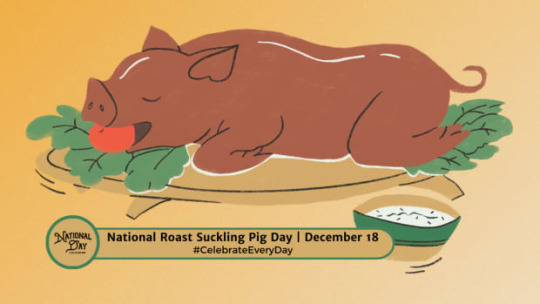


1788 – Ferdinand Philipp Grimm, born in Hanau, Germany, (d.1845) was a German collector of sagas. He is known as the "unknown brother" of the Brothers Grimm, Jacob and Wilhelm. The portrait above, of Ferdinand at 19 years old, was drawn by his artist brother Ludwig Grimm.
From 1815 he worked as a proofreader at the Berlin publishing house Reimer and was financially supported by his brothers Jacob Grimm and Wilhelm Grimm. Dismissed from the publishers in 1834, he lived with his brothers in Göttingen until 1836 , then as a writer in Wolfenbüttel.
He helped his famous brothers collect legends, but also published three collections of his own under the pseudonyms Lothar , Philipp von Steinau and Friedrich Grimm.
Heiner Boehncke writes that Ferdinand was wrongly overshadowed by his brothers, as his fairy tales are of very good literary quality. He writes that Ferdinand was very lonely and that this showed in his work.
Jacob and Wilhelm Grimm wrote in a several letters that their brother was extremely strange and the Germanist Heiner Boehncke came to the conclusion that Ferdinand had come out as homosexual during the Grimms' public Christmas party in 1810.
When he was dying, Jacob visited him, but Wilhelm had broken off contact completely.

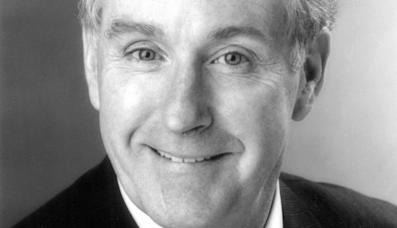
1939 – Born in Leavenworth, Texas, gay rights activist Tim Campbell (d.2015) was perhaps best known as the publisher of the GLC Voice newspaper in Minneapolis, which came out from 1979 through 1992. During that period he was the go to person in Minneapolis for the media whenever they needed a quick quote on some gay related event. Campbell was also known for a number of street theater type gay rights protests scattered over the years.
Campbell was pushed into an openly gay lifestyle by the US Army in 1962 when he was called to register for the draft. He checked the box for people who had “homosexual tendencies” even though he had never yet acted on them. For years thereafter, Campbell had to list "1Y" as his draft status on every application for employment he filled out. This had a chilling effect on his pursuit of respectable employment, so he worked in department stores and waited tables.
Bruce Brockway partnered with him to start the Positively Gay newspaper, which became the GLC Voice newspaper.
Campbell himself often said his most important contribution to the national drive for gay rights was the energy he put, during 1974 and 1975, into convincing the Advocate (a national gay publication), the Minneapolis and St. Paul newspapers, including the university's Minnesota Daily, the Washington Post, Dear Abby (Van Buren), and the New York Times to direct their style sheets to use "gay" or "gay and lesbian" or "lesbian and gay" instead of "homosexual". Ever since the mid 1960s, gays themselves throughout the gay bar system and other fledgling organizations had started using "gay" for themselves.
Campbell was also very involved in helping gays, lesbians and others to recover from alcoholism and drug addiction. He sobered up August 25, 1973, in Minneapolis. He was the founding Chair of the Lambda Sobriety Center in Minneapolis in 1981.
Tim Campbell died December 26, 2015, in Houston, Texas, at the age of 76, from esophageal cancer.


1945 – Robert Eads (d.1999) was an American trans man, whose life and death was the subject of the award-winning documentary Southern Comfort.
Eads began transitioning in his forties, after a marriage to a man and after having borne two children. Eads later described being pregnant as "the best and the worst (time) in my life," as he was thrilled by the feeling of having another life grow inside him, but was also disgusted by the fact that his pregnancy made him as a trans man feel even more "trapped" inside his female body. He divorced his husband after the birth of their second son, and presented for some time as a lesbian, though he would later point out that he always viewed his attraction to women as the product of being a heterosexual man rather than a homosexual woman.Eads began transitioning in the late 1980s following a move to Florida. He began testosterone therapy and underwent a modified double mastectomy to create a male physique. However, given his age (early- to mid-40s) as well as the fact that he had already begun to show symptoms of menopause, Eads was counseled that he would not need to undergo a hysterectomy and oophorectomy as part of his sexual reassignment. Eads transitioned later in life and as such it was deemed unadvisable to seek surgical sex assignment to male genitalia. Eads never underwent phalloplasty, and retained external female genitalia throughout his entire life. After living in Florida for some time, and following the failure of his second marriage (to a female psychologist), Eads moved back to Georgia in 1996.
In 1996, after a severe bout of abdominal pain and vaginal bleeding, Eads sought emergency medical treatment, and received a diagnosis of ovarian cancer. However, more than two dozen doctors subsequently refused to treat Eads on the grounds that taking him on as a patient might harm their practice.
It was not until 1997 that Eads was finally accepted for treatment by the Medical College of Georgia hospital, where he underwent surgical, medical, and radiation therapy over the next year. At the time Southern Comfort was filmed in 1998, his cancer had metastasized to the uterus, cervix, and other abdominal organs, and his prognosis was poor. Despite aggressive treatment, Eads died in a nursing home in 1999 at the age of 53.


1950 – Ankha Shamin (nee Donn E. Holley d.2012) was a committed activist for gay rights beginning in the 1970s with the Mattachine Society of New York.
He was born in Rochester, New York. He graduated from Buffalo State University, New York. Most recently he worked as a records manager/senior analyst at Allianz Life and was previously employed as a reference and corporate librarian for Minnesota Technology and Braun Intertec.
Early years in Minneapolis found him singing with the Twin Cities Gay Men’s Chorus and helping to develop and facilitate “Voices and Visions.” He trained with the School of Body Electric organizing and facilitating numerous BE workshops here in the Twin Cities. He avidly participated in the Mankind Project Rainbow Circles and Midwest Radical Faeries.
His life partner and soulmate, Mark S. Mueller, died some time before him.


1990 – Anthony Bowens is an American professional wrestler signed to All Elite Wrestling.
Bowens was born in Nutley, New Jersey. He attended Nutley High School and Montclair State University. He played baseball for eleven years, including at Montclair State and Seton Hall University. He was discovered by professional wrestler Santino Marella, who asked him whether he had ever thought about professional wrestling. He went on to train under Pat Buck.
Bowens started training in 2012 and made his professional wrestling debut in 2013. In November 2016, he suffered a concussion during a match on WWE NXT. In November 2020, All Elite Wrestling President Tony Khan announced that Bowens, alongside Max Caster, had been signed to a five-year contract with the promotion. The announcement also stated that Bowens and Caster would compete as a tag team named The Acclaimed.
Bowens came out as bisexual in January 2017 (he now identifies as gay), showing courage and bravery in that decision, and acting as another role model in the world of pro wrestling.
“It means something when a person can see someone that looks like them, gets them, and understands what they’re going through,” said the 28-year-old Bowens.
“I’m representing the LGBT community and athletes that are LGBT, but even more than that, too. I’m representing the small-town kid who was told he’d never make it, and I’m here for the shy kid that is ready to burst out of his shell and be that beautiful butterfly."


1997 – Navy Secretary John Dalton denied that the US Navy violates the "Don't ask, don't tell" policy by participating in witch hunts.


14 notes
·
View notes
Photo

Charlotte, Countess of Hanau-Lichtenberg (2 May 1700, Bouxwiller – 1 July 1726, Darmstadt) was the wife of landgrave Louis VIII of Hesse-Darmstadt.
1 note
·
View note
Photo
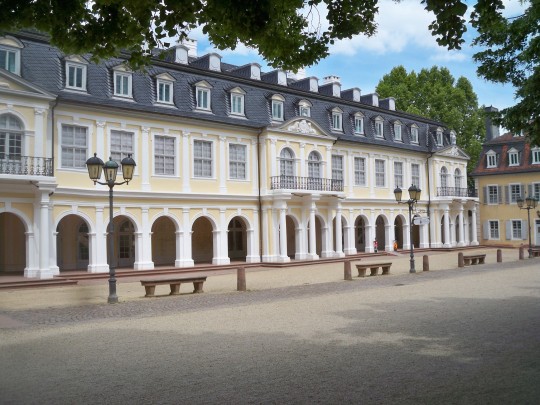
The former spa house of Wilhelmsbad. It now houses the hessian doll and toy museum.
2 notes
·
View notes
Text
WhereIB2 Land in Darmstadt Germany Munich for Oktoberfest Yea sucker's Graffenweir, Wurzburg, Heidelberg , Mannheim, Wiesbaden, Hanau, a lunch in Schweinfurt, Koln, Rein Mein River boating on a couple romantic float even the KTown Lest never forget Amsterdam In there somewhere bicycles everywhere Tripping M M canceled the show but graced with Soulfly Why hair colored kool aid? Machines and parts in Alabama Eureka Springs to Elvis’ backyard Back to U.S. leave, Owensboro the deep depp beauty land Kentucky To the grand American mountains of Colorado Fort Carson Trips to California, Pinion Canyon sitting on a rock in nowhere Outings to the field of surrounding areas North west to Oregon saw the steps of The Postman had bite in Portland Austin TX Ink to skin while on tour Hotel behind Colorado Music Hall Albuquerque, New Mexico My work zero flaws on percussion flaw Rocky Mountain Thunder Rally Slippin’ ink in skin leather clad biker babes But I was tattoo working Back to end of trails Oklahoma Back to Phoenix for a wedding Fort Worth TX museums Houston Texas for a time, zoo & butterflies, drive in for HungerGames and grand Egyptian artifacts the lovely interstates that take all day, jelly fish stings in Galveston throwing rings for grand sized teddy bears San Antonio Alamo SeaWorld and River walk NASA Aquarium extravagant parties with oil money Woodlands mall & concerts Table Rock Missouri Some cool caves in Arkansas New Years New Orleans & visit The latter the better with alligator Back to FortWorth for some master Caravaggio Tool & Cooper Restaurant A one night Phoenix trip for birthday Even back to Colorado to Crescent Butte Pikes Peak uno hike at one time Up and down a mountain Lightning crashing down Driving through the Smokey Mountains to North Carolina for a visit but with Washington D.C. again, an ultimate must Even a walk around the White House grounds when headed back a must At Lorraine Motel just for deepening further understandings Still here in Oklahoma Watching happenings commence Just places of some,more with people on a later
2 notes
·
View notes
Photo
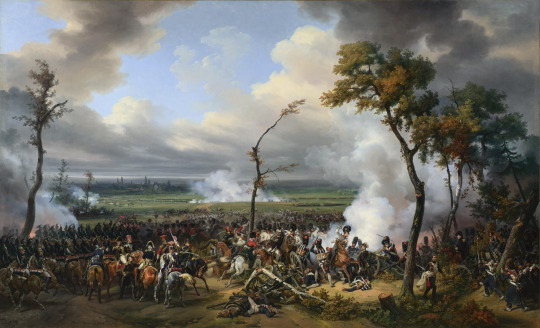
Battle of Hanau by Horace Vernet (1824). “The Battle of Hanau (30-31 October 1813), took place between Austro-Bavarian forces and French forces. This scene illustrates the attack of the Austro-Bavarian cavalry charging the French Grand Battery. Commanding the French Grand Battery is General Antoine Drouot (depicted on the right side of the painting, with an Austrian cavalryman meaning to strike him down). It also illustrates the French Guard cavalry countercharging the enemy cavalry, with its commander, General Nansouty (illustrated on the left-centre of the painting, with his back to the viewer) directing the operation.” Source

le Général Drouot

le Général Nansouty (his queue)
__________
In the Memoirs of François d’Orléans (Prince de Joinville, youngest son of Louis-Philippe), this painting was in their chateau. It was commissioned by Louis-Philippe before he was King, he was duc d’Orléans at the time. Little Joinville was very impressed by General Drouot, who was a visitor to their house; and he wanted to join the artillery because of this painting. (He went into the navy.) This memoir is in English on gutenberg.org
#Horace Vernet#Napoleonic Battles#German campaign 1813#Nansouty#Drouot#paintings of Louis-Philippe#Joinville memoir
27 notes
·
View notes
Link
By Anti-Imperialist Front
Tobias Rathjen, a 43-year-old German man, entered two different cafes in the city frequented mainly by citizens from non-European countries, opening fire. Then he returned to his home, killed his mother and committed suicide. Provisional balance sheet: 11 dead and several injured.
Among the victims, all of foreign origin, are mainly Turks and Kurds. According to the media, the assault in the two cafes was carried out by a man suffering from a serious psychiatric illness, but he had a weapons license and openly sympathized with the neo-Nazi fringes, he incited racial hatred on social media, and last year he wrote a manifesto calling for the total destruction of most countries in North Africa and the Middle East.
After the massacre, a note found in his house said, “Arabs and Muslim Turks must be exterminated.”
The massacre is part of a disturbing trend of growing violent fascist and racist attacks. But it could not be otherwise, since there are (not only in Germany) extreme right-wing parties such as the Alternative für Deutschland (Alternative for Germany, AfD), which feed undisturbed on racial tensions.
#Hanau shooting#Germany#AfD#racism#imperialism#fascism#Turkey#Kurds#massacre#antifascist#anti-imperialist#Europe#migrants#refugees#AIF#Struggle La Lucha
13 notes
·
View notes
Text
The Big Bad Homo-Economicus
My Google Drive is running out of space again and I don’t want to pay for more storage, but I don’t want to let go of these gems from college either. Here’s yet another writing assignment from my Art History class, freshman year, about Little Red Riding Hood through the ages. Enjoy!
The first recorded version of the story was that of Charles Perrault, Le Petit Chaperon Rouge (The Little Red Riding Hood), published in 1697. The major, striking aspects of the story with respect to the prevailing economy of seventeenth century France, are the contents of the basket, the location of the grandmother’s house, and the presence of woodcutters. Perrault had produced this story for the ostentatious halls of King Louis XIV, better known as the Sun King. At this time, France was pursuing the plan for a centralized economy that had been laid down years before, by the deceased finance minister, Jean Baptiste Colbert. As per his manifesto, production of normal goods was decreased and production of luxury goods was increased. This was primarily to maintain a standard of French goods for foreign trades. However, this led to an increase in taxes, which also facilitated the luxuries enjoyed by the royal authorities in Versailles while the rest of France remained in poverty. It was at this hour that the reigning Queen, Marie Therese had said exasperatedly to a group of angry and hungry peasants, “Qu'ils mangent de la brioche”. While a rough translation would mean “Let them eat cake”, brioche is actually a type of cake or bread with high butter and egg content. It is intriguing as to how Perrault chose exactly those ingredients to be in the little girl’s basket, i.e., cake and a small pot of butter. One can only assume that Perrault’s reference may have been intentional, but the relation is, nevertheless, uncanny. If this was a satirical reference then it reflects the failure of French absolutism that prevailed.

Once upon a time, in seventeenth century Paris, the supervisor of Royal Buildings, Charles Perrault decided to publish an oral folktale about a little girl being deceived and eaten by a wolf. A century later, two folklorists, the Grimm brothers, hailing from Germany, published their own version of the same tale. As the years passed, more renditions of The Little Red Riding Hood, emerged by various authors from all over the world, and it continues to be so. The plot of this popular children’s story remained the same, but the characters evolved with time and the contents in the story were often manipulated. The reason for this has been credited to the socio-economic conditions of the respective time period in which each of the versions were published. As the Grimm brothers would call the story, it was “poetry of the people”. It’s true that the surrounding situations have influenced the evolution of the story over centuries. The Little Red Riding Hood in itself is an anthology of economic concepts and issues, and its various versions substantiate the difference in economic thought and action in the time period and location in which the respective story was published.

The first recorded version of the story was that of Charles Perrault, Le Petit Chaperon Rouge (The Little Red Riding Hood), published in 1697. The major, striking aspects of the story with respect to the prevailing economy of seventeenth century France, are the contents of the basket, the location of the grandmother’s house, and the presence of woodcutters. Perrault had produced this story for the ostentatious halls of King Louis XIV, better known as the Sun King. At this time, France was pursuing the plan for a centralized economy that had been laid down years before, by the deceased finance minister, Jean Baptiste Colbert. As per his manifesto, production of normal goods was decreased and production of luxury goods was increased. This was primarily to maintain a standard of French goods for foreign trades. However, this led to an increase in taxes, which also facilitated the luxuries enjoyed by the royal authorities in Versailles while the rest of France remained in poverty. It was at this hour that the reigning Queen, Marie Therese had said exasperatedly to a group of angry and hungry peasants, “Qu'ils mangent de la brioche”. While a rough translation would mean “Let them eat cake”, brioche is actually a type of cake or bread with high butter and egg content. It is intriguing as to how Perrault chose exactly those ingredients to be in the little girl’s basket, i.e., cake and a small pot of butter. One can only assume that Perrault’s reference may have been intentional, but the relation is, nevertheless, uncanny. If this was a satirical reference then it reflects the failure of French absolutism that prevailed.

Another intriguing aspect of the story is the Grandmother’s house. Red Riding Hood describes it as the first house in the village next to a mill, which is very far away. Given the economic manifesto provided by Colbert, it can be assumed that the mill in question was for a specialized good. However, the product of the mill is not mentioned and is open to interpretation. The presence of the mill suggests the changing technology in production, which would eventually lead to the Industrial Revolution in the coming century.
Agriculture has always been a predominant occupation in France, especially in the given setting of an early modern French village. But Perrault chose woodcutters over any other laborers. The reason for this is more psycho-sociological than economic. The woodcutters, with their arms not only intimidate the wolf, but also render Red Riding Hood’s character passive, i.e., by implying the dependence on men for protection. However, from an economic perspective it is curious that if the wolf was hungry indeed, why didn’t he feed on the woodcutters and wait for Red Riding Hood? The opportunity cost of not feeding on the woodcutters was quite high. Not only did he have to starve for longer, to wait for Red Riding Hood, but he also had to go to great lengths to actually be able to eat her. The utility that he’d have gotten from eating the two woodcutters would have been equal to the utility he received from eating the grandmother and the girl. This may be because the wolf was able to assess the risks of eating the woodcutters. It would have been one against two armed men. As the first principle of risk management states: the gain must exceed the pain. The wolf might have realized that the margin of risk with Red Riding Hood is much lesser than that of eating the woodcutters, which could increase his probability of being killed. Thus, the wolf represents a true Homo economicus or “economic man” who only caters to selfish motives while making a rational economic decision. The wolf abides by economic laws while making this decision but fails to do the same later when he contradicts the Law of Diminishing Marginal Utility which states that with every successive unit of consumption the utility derived from that additional unit decreases. The wolf is more satisfied by eating Red Riding Hood than he is by eating the grandmother even though he was hungrier when he ate the latter.

This discrepancy was addressed in the version published two centuries later by Jacob and Wilhelm Grimm, Rotkappchen (Little Red Cap) in 1812. In this version the wolf specifies that the little girl would be much more satisfying than the old grandmother, because the girl’s flesh is tenderer.The wolf wishes to capture both to satiate his hunger, thus treating the grandmother and the little girl as parts of a single source of utility.
The Grimm brothers were German philologists whose expertise was in collecting popular folktales. The time the Grimm version of the Little Red Riding Hood was published; France was dominating the European economy and facing a revolution. The Germans were lagging far behind in economic development. Their economy was feudal and traditionalism was widespread. Germany had yet to catch up with technological advancements. This probably explains the location of the grandmother’s house being so deep in a forest as Germany was more of a rural society than urban at the time.

This was also a time of poverty and poor health across Germany. This makes the grandmother’s illness more credible. J.J. Sheehan , an American historian, notes that “even in the best of times the poorest families spent most of their income on food; when prices rose they bought less, ate less, and became susceptible to typhus, typhoid, and the other infections that raged throughout these years.” This explains why Red Riding Hood’s mother gave her a basket full of food to take to the grandmother instead of medicines. However the food items in the basket were cake and wine which are considered luxury items. Luxury items are goods that are purchased upon an increase in income, unlike necessities which are not as affected by income. This helps to hypothesize that The Little Red Riding Hood came from a comparatively better off background. Her velvet red cap also supports this theory as velvet used to be associated with nobility. However this contradicts the feudalism spoken of before.
This can be explained by the history of the Grimm brothers themselves. They were raised in the bustling town of Hanau, and the Grimm family was among the cream of the society. Despite living a life of comfort, Jacob and Wilhelm, as Jack Zipes records, were very much familiar with things relating to rudimentary lifestyles such as farming, peasant customs and superstitions. This depicts the aforementioned traditionalism that prevailed in the German society. It also provides a better understanding of Red Riding Hood’s character. Her character can be easily related to the lives of the Grimm Brothers.

In the Grimm version of the story, the little girl’s credibility was still suppressed by the hunter who saved her life. But Roald Dahl allows Red Riding Hood to have her moment of bravado in Little Red Riding Hood and The Wolf. This poem was published in 1983, which was the same time when Margaret Thatcher had taken up the seat for Prime Minister of the United Kingdom for the second time. This was a time when women were making a difference in various occupational fields during the second wave of the Feminist Movement. Margaret Thatcher strived for a modernized economy and used uncompromising techniques to implement economic policies that saved the United Kingdom from its recession. Her methods earned her the nickname “the Iron Lady”.
Roald Dahl is renowned for his satire, wit and humor. His poem of the Red Riding Hood Story may have been his own interpretation. However, the facts of the time period in which it was written allows me to infer a relation between Roald Dahl’s Little Red Riding Hood and Margaret Thatcher. In 1983 Margaret Thatcher was re-elected as the post of Prime Minister after she picked herself up from the recession in the beginning of the 1980s. Similarly Red Riding Hood had been in a low point of her own in the previous versions of her story wherein she was killed, saved by someone else or identified as a sex object. Roald Dahl gave her the opportunity to take control of the story without compromising her dignity or sovereignty and she proved herself to be an Iron Woman by killing the wolf. In this instance Red Riding Hood becomes the Homo economicus. Without letting any other emotions override, she shoots the wolf. The opportunity cost of letting it live would be the price of her life and many others. Many behavioral economists believe that the opportunity cost of selfish behavior is rather high that they might encourage unrelated motives. For example, like most female protagonists of fairy tales, Red Riding Hood could have shown compassion towards the wolf, which could have unreliable consequences, i.e. good or bad. A rational economist would ignore nonegoistic motives, like the Homo economicus or Red Riding Hood. Thus, Red Riding Hood, for once, has been described as the ideal role model not for her morals but for her actions.

Thus, every development in the story of Little Red Riding Hood, in all the versions, has some kind of economic dimension to it that can often be derived or integrated into the real world at the given time period. The different versions show the changing economic perspectives. In Perrault’s version of Le Petit Chaperon Rouge we see a reflection of the early modern French society, where the male figure (the wolf) makes rational economic decisions. In the Grimm version, we see an influence of a better standard of living through Red Riding Hood. And finally, in Dahl’s poem, we see the woman making the rational economic decisions. The evolution of the Red Riding Hood story helps to map out the economic development of the society over centuries and hence, may even serve as historical evidence.
[My Bibliography was 3 pages more so I thought I’d spare you. Rest assured it’s available on demand]
4 notes
·
View notes
Text
The Hanau shooting and immigration
Yesterday I attended a 'Mahnwache', a vigil. It was for the victims of the shooting in Hanau that occurred on Wednesday. Ten people were killed in a Shisha bar in the city of Hanau, just a 30 minute subway ride away from me, by a right-wing extremist.
Over 5000 people crowded together, standing next to Paulskirche in Frankfurt. People of all nationalities were there while politicians and representatives of immigration and religious services took their two minutes on the mic.
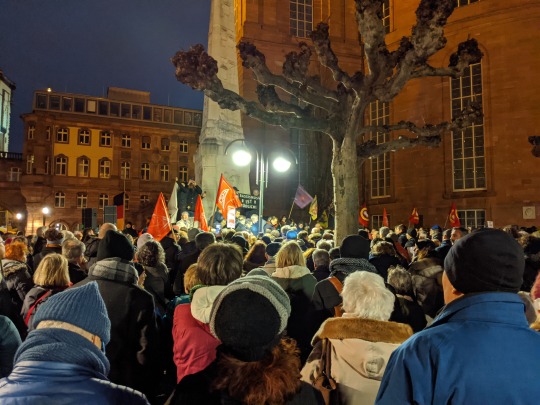
The statement conveyed was clear; We stand together against racism.
Crisp winds wove between us as we stood, and the podium beat out a message.
Speak out.
Stand up.
Be silent no more.
I was freezing. A memory of waiting outside the Ausländerbehörde came to the forefront. Sitting in my camping chair and huddled in my sleeping bag I waited outside the doors. It was close to midnight and I was falling in and out of sleep somehow. Suddenly an employee opened the door, and those in line were scrambling to get in. A turkish man, who had been waiting next to me, stopped the others, "She's first" he said. Me, in all intents and purposes a white, blond haired and blue eyed woman. He had every reason not to do me the favor, but that didn't seem to be a question for him. I was a person.
My thoughts wandered. Offenbach, my home, is filled with languages, colors, religions and ethnicities from all over the world. People going to work, smoking a cigarette, chewing gum, having a coffee, smiling at one another, helping each other.
There is a saying in Frankfurt, that nothing good comes from Offenbach. I asked some people last night why citizens of Frankfurt disliked Offenbach so much. They said it was a normal rivalry, like between any two cities so close to one another. Soccer related probably, they said. And sure, they said, probably some racism there too because everyone knows Offenbach is culturally very different. But for me it often feels laced with hidden meanings. "Some" racism isn't how I would put it.
A majority of my coworkers are all immigrants. On a daily basis I see racism. My German is good enough, and I'm white so I'm often mistaken as Dutch. I live in this between world and often hear both sides of the story, because I look 'native' and can play the part but I'm also an immigrant. Surprise! I came here for a better life, an american in Germany. Wahnsinnig.
Immigrants are the gravel upon which society stands. Shifting and moving, pushed down further into the mud but still supporting. Their place isn't secure, but they often stand together. In the US or in Germany, they clean our homes. They take care of our elderly, build our houses and roads, they pick up our trash. They are the foundation of our world. Without them we fall, unsupported and flailing in a pile of rotting sewage.
Be reverent toward those who are your foundation. Soon we will be a world without borders. Walls have no meaning, and are for those who do not understand or don't want to understand.
The rain does not stop falling because you put up a roof.
5 notes
·
View notes
Photo

On this day in royal history . 5th March 1723 . Princess Mary of Great Britain was born . About Mary; . . ◼ Princess Mary was born at Leicester House, Westminster, London. Her father was the Prince of Wales, later King George II. Her mother was Caroline of Ansbach, daughter of Johann Friedrich, Margrave of Brandenburg-Ansbach. . ◾ Her father succeeded, as George II, on 11 June 1727, & she became HRH The Princess Mary. . ◼ A marriage was negotiated with Landgrave Frederick of Hesse-Kassel, the only son & heir of William VIII, Landgrave of Hesse-Kassel. For the marriage, Parliament voted Mary £40,000. . ◾ They married by proxy at the Chapel Royal of St. James’s Palace in London on 8 May, then in person on 28 June 1740 at Kassel. The marriage was unhappy, & Frederick was said to be “brutal” & “a boor”. . ◼ In late 1746, Mary made an extended trip to Britain to escape his maltreatment. The couple separated in 1754 on Frederick’s conversion to Roman Catholicism. . ◾ They had four sons, three of whom survived to adulthood. In 1756, Mary moved to Denmark, to take care of the children of her sister, Louise of Great Britain, who had died in 1751. . ◾ She took her children with her; they were raised at the royal court & her sons were married to Danish princesses. Her husband succeeded his father as Landgrave of Hesse-Kassel in 1760, & so Mary was technically Landgravine consort for the last twelve years of her life, despite her estrangement from her husband. . ◾ Mary died on 14 or 16 January 1772, aged 48 at Hanau, Germany. . . . #Onthisdayinhistory #Thisdayinhistory #TheYear1723 #d5mar #HouseofHanover #PrincessMary #PrincessMaryofGreatBritain #GreatBritain #RoyalHistory #RoyalFamily #Royals #monarchy #PrincessofHesseKassel #BritishMonarchy #RoyalHistory #HistoryFacts #Otd #OnThisDay #britishroyals #Britishroyalfamily #Britishroyalty (at Westminster) https://www.instagram.com/p/B9Xfj7upvMY/?igshid=1fuy1f653hnce
#onthisdayinhistory#thisdayinhistory#theyear1723#d5mar#houseofhanover#princessmary#princessmaryofgreatbritain#greatbritain#royalhistory#royalfamily#royals#monarchy#princessofhessekassel#britishmonarchy#historyfacts#otd#onthisday#britishroyals#britishroyalfamily#britishroyalty
3 notes
·
View notes
Video
Old Castle and now Museum in Steinheim (Hanau) - Germany 2020 by Dieter Lochschmidt Via Flickr: Altes Schloss und jetzt Museum in der Altstadt Haunau-Steinheim Von Museum Schloss Steinheim "Inmitten der Altstadt von Steinheim mit seinen gemütlichen Gaststätten und Apfelweinkneipen befindet sich Schloss Steinheim. Die Burg Steinheim, erstmalig erwähnt im Jahr 1222 , war rund 370 Jahre im Besitz des Kurfürstentums Mainz. 1808/13 erfolgten Umbauten im klassizistischen Stil und prägen das heutige Erscheinungsbild des Baues. In diesen historischen Gemäuern befindet sich seit 1938 ein Museum. Nach längeren Sanierungsarbeiten am Gebäude und einer Neukonzeption des Museums wurde 1986 das regionale Vor- und Frühgeschichtsmuseum der Stadt Hanau eröffnet. Die Exposition umfaßt die ersten menschlichen Spuren, die revolutionäre Entdeckung der Bronze, die Hinterlassenschaften der Römer bis zu den Relikten des frühen Mittelalters.
Old castle and now museum in the old town Haunau-Steinheim Von Museum Schloss Steinheim "In the middle of the old town of Steinheim with its cozy restaurants and cider pubs is located Schloss Steinheim. Steinheim Castle, first mentioned in 1222, was owned by the Electorate of Mainz for about 370 years. In 1808/13, reconstructions were carried out in the classicist style and shaped the present appearance of the building. A museum has been housed in these historic walls since 1938. After lengthy renovation work on the building and a redesign of the museum, the regional prehistory and early history museum of the city of Hanau was opened in 1986. The exposition includes the first human traces, the revolutionary discovery of bronze, the legacies of the Romans up to the relics of the early Middle Ages."
2 notes
·
View notes
Photo

December 22, Frankfurt - Gemeint sind wir alle! Demo gegen rechte Brandstifter*innen
Protest against right-wing arson attacks During the last weeks, the Rhine-Main area experienced a total number of seven arson attacks targeting left-wing projects. Timing and procedure of all arsons were so similar which leads to the assumption that we currently find ourselves confronted with a connected series of attacks. Targets have been Frankfurt's 35-year squatted Au, syndicate housing projects Knotenpunk in Schwalbach, Assenland in Frankfurt Rödelheim, Schwarze 7 in Hanau as well as cultural centre Exzess in Frankfurt Bockenheim. Analysing the nature of the affected projects, we must assume that we have faced targeted, right-wing attacks against alternative and left-wing structures. As these are symbols for the idea of a communal lifestyle far from discrimination and exploitation, they have always been a thorn in the right-wing's and fascists' sides. This is why we understand the attacks on these projects as an attack on everybody contributing to an open and solidary society. Right-wing violence does not only target left-wing structures but particularly all those that do not fit into a right-wing worldview (migrants, Muslims, Jews). We have seen attacks against homeless Roma people, an attack on the premises of antiracist Project Shelter in 2016 and the repetitive desecration of Jewish memorials and graveyards. However, right-wing violence is not born in a vacuum. Prior to the violent acts, there was a public dialogue characterized by hatred, discrimination and baiting - just like the discussions in Frankfurt's town hall Römer regarding left-wing projects and activists, migrants or unemployed people. As a result on 22 December, we intend to take our protest against right-wing arsonists and their advocates (from CDU, FDP to AfD) to the street. This is where we proof our response to hatred and discrimination is solidarity and support. There is no room for racism, antisemitism and baiting in the Rhine-Main area.
#germany#deutschland#antifa#antifascism#antifascist action#antifaschismus#antifaschistische aktion#frankfurt
6 notes
·
View notes
Text
Title: Identitti Author: Mithu M. Sanyal Translator: Alta L. Price Translation Publication Date: July 2022 Publisher: Astra House Genre: fiction
I want to first preface that I am not German, nor do I live in Germany. I think this is rather important to highlight because it is very clear that Sanyal is writing with a German audience in mind. On top of this, I’m reading a translation of the book, so I’m inevitably going to miss some nuances. That being said, I can understand a lot of the academic discourse in this book, being in academia myself. I can also understand what it’s like to not be white in a predominantly white space.
Anyway, as a non-German reader who doesn’t live in Germany, this book was interesting to read, especially because I got a glimpse of how racial identity politics was working outside the Anglosphere. It’s clear that Sanyal drew inspiration from the Rachel Dolezal scandal (which did happen in the United States), who pretended to be Black but is actually white. In Identitti, the character, Saraswati, did something similar, except she pretended to be Indian. There’s also the fact that Saraswati’s research focused on race and postcolonialism (welp). Furthermore, her ideology and accomplishments were all built on her masquerading as a Brown woman. When Nivedita, a biracial (Indian and white German) student working with Saraswati, discovered this, it understandably sent her reeling. However, another reason her world was upended was because it put to question her own racial identity, which she has struggled with most of her life. Who gets to decide how you identify racially in a country like Germany? Can being “transracial” actually be a thing?
There were some interesting (even clever) points made throughout this book about identity, but damn, was it executed poorly. The discussions just went in circles to the point of exhaustion, and by the end of the book, it didn’t really reach a conclusion on whether what Saraswati did was okay or not, which… bothered me. A lot. The characters were also exhausting to deal with, having over-the-top, grating personalities. I understand that satire often means excess, but there is such thing as too much. In addition, these characters had a lot of contradicting opinions, which combined with the roundabout discussions, really frustrated me. As a result, I think Sanyal’s satire backfired and ended up with her validating Saraswati’s actions. It’s really unfortunate, because there were a lot of opportunities that would have made this book a really effective piece of satire. Something else I should add is my jaw dropped when Sanyal used the Hanau shooting as a plot device, and it played a relatively big part in the direction of the (admittedly, near-absent) plot.
I think on the more logistical side of things, there were far too many moving parts (and a lot of them were weird) for one book, with Sanyal getting sidetracked by an array of things. One thing I did appreciate was the translator’s note on how she approached the text. I wish more could have been said about particular word/term choices, such as “BIPOC,” but this is more a personal interest in her approach to localization.
Again, I think it’s important to be mindful of where you’re from when reading about discourse on identity in other countries, because, well, they play out a little differently. Whether you take this into consideration or not, though, I have to say that this was a pretty exhausting book to get through that could have been a lot shorter and clearer.
Content Warning: racism, cultural appropriation, hate crime, mass shooting, toxic relationship, sexism, some gaslighting, mentions of death and colonization
0 notes
Photo

Portrait of Amalie Elisabeth von Hanau-Munzenberg - Gerard van Honthorst
Amalie Elisabeth of Hanau-Münzenberg (1602–1651) was Landgravine consort and Regent of Hesse-Kassel. She married the future William V, Landgrave of Hesse-Kassel in 1619 and became Landgravine upon his ascension to power in 1627. In 1637, military defeats forced her and William V into exile in East Frisia. Later that year, she became regent for their son William VI upon her husband's death. Through skillful diplomacy and military successes in the Thirty Years' War, she advanced the fortunes of Hesse-Kassel and influenced the Peace of Westphalia that brought the conflict to an end. She handed over an enlarged landgraviate to her son when she abdicated upon his majority in 1650. However, her health had deteriorated over the course of the war, and she died soon after her abdication in 1651.
#Amalie Elisabeth of Hanau-Münzenberg#House Hanau#XVII century#gerard van honthorst#people#portrait#paintings#art#arte
1 note
·
View note
Photo

To remember is to fight. ✊️ 30 years later - Germany still has a racism problem. The racist pogroms in Lichtenhagen in August 1992 marked a new high point in right-wing violence in post-war Germany. The day-long riots around the sunflower house escalated due to a previous inhuman and ignorant debate on asylum, as it is currently being conducted again, at least since 2015. History has shown that words are followed by deeds. The German mob was ready, for days Nazis and racists rioted against the "Central Reception Center for Asylum Seekers" (ZAst) and besieged a dormitory for Vietnamese contract workers. They attacked the house and the families holed up in it with stones and incendiary devices. The police failed and at times withdrew completely. Cheering and applauding, a mob of up to 3,000 sympathizers stood by the rampaging Nazis. The victims were not compensated. Today, quite a few political parties are creating a social climate that can trigger similar pogroms. We remember, we commemorate, we act, we keep fighting! For diversity and solidarity! For equality and tolerance! For an open and colorful society! Never again Lichtenhagen. Never again Heidenau. Never again Hanau, Halle,... 👊 . . #alltagsrassismus #alltagsrassismusbekämpfen #antifa #antifacista #antifascism #antiracism #fcknzs #fuckrassismus #gegenrassismus #gegenrechts #Gerechtigkeit #gesichtzeigen #immerundüberall #keinbockaufnazis #keinplatzfürrassismus #keinvergeben #keinvergessen #lichtenhagen #nichtvergessen #niewieder #niewiederfaschismus #noracism #progrom #rassismus #rassismusbekämpfen #rassismusistkeinealternative #Refugees #rostock #stopptrassismus #wirsindmehr (at Lichtenhagen) https://www.instagram.com/p/Choa_s1vp_o/?igshid=NGJjMDIxMWI=
#alltagsrassismus#alltagsrassismusbekämpfen#antifa#antifacista#antifascism#antiracism#fcknzs#fuckrassismus#gegenrassismus#gegenrechts#gerechtigkeit#gesichtzeigen#immerundüberall#keinbockaufnazis#keinplatzfürrassismus#keinvergeben#keinvergessen#lichtenhagen#nichtvergessen#niewieder#niewiederfaschismus#noracism#progrom#rassismus#rassismusbekämpfen#rassismusistkeinealternative#refugees#rostock#stopptrassismus#wirsindmehr
0 notes
Text
𝗙𝗘𝗔𝗧𝗨𝗥𝗘𝗗 𝗜𝗡 𝗧𝗛𝗘 𝗡𝗘𝗪𝗦 📰 . . . 𝗧𝗛𝗘 𝗟𝗜𝗡𝗞𝗦 𝗘𝗦𝗧𝗔𝗧𝗘𝗦 𝗔𝗧 𝗙𝗜𝗦𝗛𝗘𝗥 𝗜𝗦𝗟𝗔𝗡𝗗
DESIGNER MODERN TUSCAN ESTATES IN AMERICA’S WEALTHIEST ZIP CODE!
Swipe to See the Publications Featuring The Links Estates
𝗕𝗹𝗼𝗼𝗺𝗯𝗲𝗿𝗴 ~ The Last 12 Houses on Florida’s Fisher Island Are Up for Sale
𝗧𝗵𝗲 𝗥𝗲𝗮𝗹 𝗗𝗲𝗮𝗹 ~ Heinrich von Hanau Launches Sales of Fisher Island Single-Family Homes with Average Price of $33M
𝗢𝗰𝗲𝗮𝗻 𝗗𝗿𝗶𝘃𝗲 ~ Fisher Island Unveils Limited Collection of Single-Family-Home Estates
𝗣𝗿𝗼𝗳𝗶𝗹𝗲 𝗠𝗶𝗮𝗺𝗶 ~ The Ultra-Exclusive Fisher Island Reveals Limited Collection of Single-Family-Home Estates
📍The Links Estates ~ Fisher Island
• Developed by Fisher Island Holdings
• Architecture by Portuondo Perotti
• Italian Interior Design by Indelux
• Landscaping by Enzo Enea
𝑬𝑿𝑪𝑳𝑼𝑺𝑰𝑽𝑬 𝑺𝑨𝑳𝑬𝑺 & 𝑴𝑨𝑹𝑲𝑬𝑻𝑰𝑵𝑮 𝑩𝒀 𝑫𝑶𝑹𝑨 𝑷𝑼𝑰𝑮
DM for Pricing & More Information 📲
📞 305.613.2118
🌐 DoraPuig.com
🥇Ranked #𝟓 𝐔𝐒𝐀, #𝟑 𝐅𝐋, #𝟏 𝐌𝐈𝐀 by The Real Trends in @wsj
💰𝐎𝐕𝐄𝐑 $𝟒 𝐁𝐢𝐥𝐥𝐢𝐨𝐧 𝐢𝐧 𝐂𝐚𝐫𝐞𝐞𝐫 𝐒𝐚𝐥𝐞𝐬 & 𝐎𝐕𝐄𝐑 $𝟗𝟕𝟎 𝐌𝐢𝐥𝐥𝐢𝐨𝐧 𝐒𝐎𝐋𝐃 𝐢𝐧 𝟐𝟎𝟐𝟏
#exclusiveestates #fisherisland #fisherislandrealestate #fisherislandestates #thelinksestates #thelinksestatesatfisherisland #movetomiami #miami #miamirealestate #miamihomes #miamiluxuryhomes #luxuryhomes #miamirealestate #miamibroker #luxurylistings #luxuryrealestate #dorapuig #luxelivingrealty #luxelivingmiami #theartofluxeliving

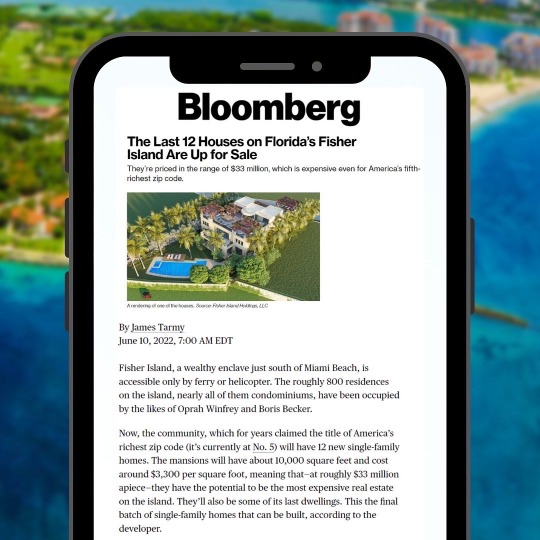






0 notes
